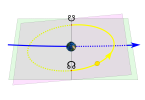If you’re new to basketball, you may be confused about the difference between a quarter and a period. Both terms are used to describe the time periods in a basketball game, but they aren’t interchangeable. Understanding the difference between a quarter and a period is essential to understanding the game of basketball.
In basketball, a game is divided into four quarters, each 12 minutes long. The clock is stopped at certain intervals during the game, such as after a made basket or when a foul is called. If the game is tied after four quarters, it will go into additional five-minute overtime periods until a winner is decided.
On the other hand, a period refers to the section of time in one quarter of a basketball game. The game clock shows how much time is left in every given quarter, starting at 12:00 and running all the way to zero.
Understanding Basketball
Basketball is a fast-paced, exciting sport that has captured the hearts of many fans around the world. Whether you’re a seasoned veteran or a newcomer, understanding the basic rules and terminology of the game is essential to fully appreciate the action on the court.
In basketball, a game is divided into four sections, which are called quarters. Each quarter is 12 minutes long, and there are breaks between each quarter and at halftime. During these breaks, players can rest, strategize, and make adjustments before returning to the court.
It’s important to note that the term “quarter” is often used interchangeably with the term “period” in basketball. However, there are some subtle differences between the two. In general, a quarter refers specifically to one of the four 12-minute sections of a regulation game, while a period can refer to any segment of time within a game, including the quarters.
In addition to the quarters, there are also overtime periods in basketball. Overtime periods are played if the score is tied after the final quarter, and they are typically five minutes long.
If the score remains tied after the first overtime period, additional overtime periods are played until a winner is determined.
Overall, understanding the basic structure of a basketball game is crucial for fans who want to fully appreciate the action on the court.
Whether you’re watching a professional game or playing with friends, knowing the rules and terminology of the sport will help you get the most out of your experience.
Definition of a Quarter in Basketball
In basketball, a quarter is a period of time during the game that lasts for 12 minutes. Each game is divided into four quarters, and the breaks between the quarters are called intermissions. During these intermissions, the teams can take a break, discuss strategy, and make substitutions.
The first and third quarters are followed by a short intermission that lasts for 130 seconds, while the second quarter is followed by halftime, which is a longer break. The fourth quarter is followed by a post-game period, which is used to determine the final score of the game.
During each quarter, the clock is stopped whenever the ball is out of bounds, a foul is committed, or a timeout is called. This means that the actual time it takes to complete a quarter can vary depending on the number of stoppages that occur during the game.
It is important to note that the length of a quarter can vary depending on the league and level of play. For example, high school basketball games are made up of four 8-minute quarters or two 16-minute halves, while NCAA college basketball games consist of two 20-minute halves. The NBA games are made up of four 12-minute quarters.
Definition of a Period in Basketball
In basketball, a period refers to a specific segment of time during a game. Each period is a set length of time, and the number of periods in a game can vary depending on the league and level of play.
In most professional basketball leagues, including the NBA and WNBA, there are four periods in a game. Each period lasts for 12 minutes, and there is a short break between each period.
In other leagues, such as FIBA and women’s NCAA basketball, there are four periods, but each period lasts for 10 minutes instead.
During each period, the clock counts down from the designated time, usually starting at 12:00 and counting down to zero. The clock can be stopped in certain situations, such as when a player calls a timeout or when there is a foul or other stoppage in play.
At the end of each period, the teams switch sides of the court. This ensures that neither team has an advantage due to factors such as lighting or wind direction.
Periods are an important part of basketball, as they help to structure the game and provide a sense of time and momentum. By understanding the definition of a period in basketball, you can better appreciate the nuances of the sport and follow the action on the court with greater clarity.
Differences Between a Quarter and a Period
In basketball, the terms “quarter” and “period” are often used interchangeably, but they actually refer to two different things. Here are the main differences between a quarter and a period in basketball:
- Length: A period is a general term that refers to any section of a basketball game, while a quarter specifically refers to a 12-minute segment of the game. Therefore, a game can have multiple periods, but it will always have four quarters.
- Structure: The four quarters of a basketball game are structured in a specific way. The first and second quarters make up the first half of the game, while the third and fourth quarters make up the second half. There is a halftime break between the second and third quarters.
- Timing: Each quarter is timed separately, with the game clock starting at 12:00 and counting down to 0:00. If the game is tied at the end of the fourth quarter, an overtime period is played to determine the winner.
- Fouls: In terms of fouls, there is no difference between a quarter and a period. Each team is allowed a certain number of fouls per period/quarter before the opposing team is awarded free throws.
- Scoring: The scoring system remains the same throughout the entire game, regardless of whether it is a period or a quarter. Each basket is worth two or three points, depending on where it is scored from.
Overall, while the terms “quarter” and “period” are often used interchangeably in basketball, it is important to understand the subtle differences between them. The four quarters of a game are specifically structured and timed, while periods can refer to any section of the game.
Duration of a Quarter and a Period
In basketball, a game is divided into four equal parts or periods, with each period lasting a specific amount of time. The duration of a quarter or period varies depending on the league and level of play.
In the National Basketball Association (NBA), each period lasts for 12 minutes, making the total game time 48 minutes. The Women’s National Basketball Association (WNBA), FIBA, and women’s NCAA basketball also have four periods in a game, but each period lasts for 10 minutes. On the other hand, in men’s NCAA basketball, there are two halves instead of four quarters, with each half lasting 20 minutes.
During a quarter or period, the clock runs continuously, except for specific situations such as timeouts, fouls, or when the ball goes out of bounds.
In between the first and second periods and the third and fourth periods, there is a short intermission of 130 seconds, while at halftime, there is a more extended break of 15 minutes.
It is worth noting that the duration of a quarter or period can affect the pace of the game. For instance, a shorter period can result in a faster-paced game, with more possessions and scoring opportunities. Conversely, a longer period can lead to a slower-paced game, with fewer possessions and scoring opportunities.
In conclusion, the duration of a quarter or period varies depending on the league and level of play, with each period lasting between 10 to 12 minutes.
The clock runs continuously during a period, except for specific situations, and there are short breaks in between periods and a more extended halftime break.
Impact on Game Strategy
Understanding the difference between a quarter and a period in basketball is crucial to developing a winning game strategy. Here are some key points to keep in mind:
- A game is divided into four quarters, each lasting 12 minutes, with a halftime break in between the second and third quarters.
- A period refers to any one of these four quarters.
- The intermissions after the first, third, and fourth quarters last 130 seconds, while the halftime break lasts 15 minutes.
- The clock stops during timeouts, free throws, and certain other situations, which can affect the amount of time remaining in a given period.
So, how does this impact game strategy? Here are a few ways:
- Managing player fatigue: With only 12 minutes per period, coaches must carefully manage their players’ minutes to avoid fatigue. This can mean strategic substitutions, timeouts, and other measures to keep players fresh throughout the game.
- Timing your runs: Because the clock stops during certain situations, teams can use this to their advantage by timing their runs to coincide with these breaks. For example, if a team is down by a few points with only a few seconds left in the period, they may try to draw a foul and get to the free throw line to stop the clock and score some points.
- Adjusting to the opponent: With four periods to work with, coaches have more opportunities to adjust their game plan based on what’s working and what’s not. For example, if an opponent is dominating the paint in the first half, a coach may adjust their defensive strategy in the second half to focus on perimeter defense.
Overall, understanding the difference between a quarter and a period is essential to developing a winning game strategy in basketball.
By carefully managing player fatigue, timing your runs, and adjusting to the opponent, you can give your team the best chance of success on the court.
Global Variations in Basketball Timing Rules
Basketball is a global sport, and as such, it has different timing rules depending on the location and level of play. Here are some of the variations in basketball timing rules around the world:
- FIBA: The International Basketball Federation, or FIBA, is the governing body for basketball worldwide. FIBA games have four 10-minute quarters, with a 15-minute halftime break. The shot clock is 24 seconds, and teams are allowed two timeouts in the first half and three in the second half. In overtime, there are two 5-minute periods with a 2-minute break in between.
- NBA: The National Basketball Association, or NBA, is the premier professional basketball league in North America. NBA games have four 12-minute quarters, with a 15-minute halftime break. The shot clock is 24 seconds, and teams are allowed six timeouts per game, with a limit of three per half. In overtime, there is one 5-minute period, with additional periods played until one team wins.
- NCAA: The National Collegiate Athletic Association, or NCAA, is the governing body for college basketball in the United States. NCAA games have two 20-minute halves, with a 15-minute halftime break. The shot clock is 30 seconds, and teams are allowed four timeouts per game, with a limit of two per half. In overtime, there are two 5-minute periods, with additional periods played until one team wins.
- High School: High school basketball timing rules vary by state and by association. In some states, high school games have four 8-minute quarters, while in others, they have four 12-minute quarters. The shot clock is not used in most high school games, and teams are allowed a limited number of timeouts per game.
It’s important to note that these are just a few examples of the variations in basketball timing rules around the world. Other leagues and associations may have different rules, and even within a single league, the rules may differ depending on the level of play. As a basketball player or fan, it’s important to be aware of the timing rules for the games you’re watching or playing in.
Conclusion
In conclusion, understanding the difference between a quarter and a period in basketball is essential for anyone who wants to follow the game. While the two terms are sometimes used interchangeably, they refer to different things.
A quarter is a specific unit of time in a basketball game, with each game divided into four quarters. In the NBA, each quarter lasts 12 minutes, while in women’s college basketball, each quarter lasts 10 minutes. In the WNBA, each game also has four quarters, each lasting 10 minutes.
On the other hand, a period refers to any unit of time in a basketball game. It can refer to a quarter, but it can also refer to any other segment of the game, such as a half or overtime period.
Knowing the difference between a quarter and a period can help you better understand the rules and structure of basketball games. It can also help you communicate more effectively with other basketball fans and analysts.
Overall, while the difference between a quarter and a period may seem small, it is an important distinction that can make a big difference in how you understand and enjoy the game of basketball.







